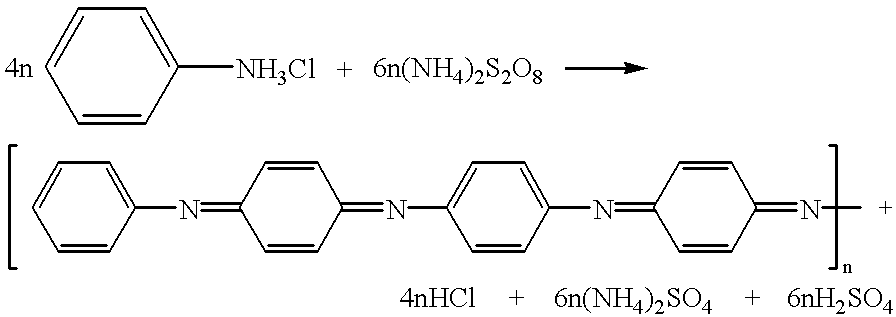Method for making polyaniline with high molecular mass in the form of emeraldine and polyniline obtained by said method
a polyaniline and molecular mass technology, applied in the direction of conductive materials, organic conductors, conductive materials, etc., can solve the problems of high molecular mass polymers that are not very valuable, can only be protonated with great difficulty by very strong acids, and can only be very valuable, and the molecular mass measurement done by sec can also give substantial errors
- Summary
- Abstract
- Description
- Claims
- Application Information
AI Technical Summary
Benefits of technology
Problems solved by technology
Method used
Image
Examples
example 1
A solution of aniline chlorhydrate is made by dissolving 10 ml (0.1097 mol) of aniline in 85 ml of 3M HCl. 95 ml of ethanol is added to this solution and 16 g of LiCl is dissolved in it.
An oxidising solution is prepared by dissolving 6.25 g (0.0274 mol) of ammonium persulphate in 60 ml of 2M HCl and 8 g of LiCl is dissolved in it.
A FeCl.sub.2 reducing solution is prepared by dissolving 3.64 g (0.0183 mol) of FeCl.sub.2 and 5 g of LiCl in 50 ml of 2M HCl.
The aniline solution is put into a small 500 ml reactor with a double wall and with stirring and the solution is cooled to -25.degree. C. by circulation of a thermostat-controlled refrigerating liquid allowing for cooling of the reactor. The APS solution is also cooled to -25.degree. C. in another refrigerator.
A Pt electrode, a reference electrode of calomel and a temperature probe with resistance of 100 * are placed into the aniline solution by means of an electrolyte bridge containing an LiCl solution in ethanol. The electrodes and...
example 2
The same approach as in example 1 is used except that a simple reactor is used and placed in a Dewar flask containing o-oxylene crystals with a melting point of -25.degree. C. The change in redox potential and temperature during this synthesis is presented in FIG. 11. The change in potential (curve 1) is similar to that shown in FIG. 1 corresponding to example 1, the change in temperature (curve 2) is also similar up to the point where the reducing solution is added. At the time of the reduction, the temperature rises sharply due to the rapid release of heat from the reduction and then it rises normally by natural heating up to room temperature.
The results of the measurements show no significant differences with respect to the results shown in example 1, indicating that the temperature at which the reduction is done has no influence on the polymer properties.
example 3
Done in the same manner as for example 1, except that the indicator temperature is set at -30.degree. C.
The change in redox potential and temperature during the synthesis is similar to that shown in example 1. The yields are the same. The only significant difference is the time of polymerisation, in this case 110 minutes.
The characteristics of the polyaniline obtained are:
Cl content of 0.5%,
inherent viscosity of 2.1 dl / g,
wavelength of the excitonic absorption peak of emeraldine base .cndot..sub.ex =678.
wavelength of the fundamental peak of emeraldine base .cndot..sub..cndot.-.cndot.* =332 nm, and
a ratio of the intensities of these peaks of I.sub.ex / I.sub..cndot.-.cndot.* =1.06
The UV, vis., near IR absorption spectrum of emeraldine does not show any significant differences with respect to that of the emeraldine synthesised in example 1 at -25.degree. C. The conductivity of the film obtained is 330 S / cm.
PUM
| Property | Measurement | Unit |
|---|---|---|
| Fraction | aaaaa | aaaaa |
| Fraction | aaaaa | aaaaa |
| Fraction | aaaaa | aaaaa |
Abstract
Description
Claims
Application Information
 Login to View More
Login to View More - R&D
- Intellectual Property
- Life Sciences
- Materials
- Tech Scout
- Unparalleled Data Quality
- Higher Quality Content
- 60% Fewer Hallucinations
Browse by: Latest US Patents, China's latest patents, Technical Efficacy Thesaurus, Application Domain, Technology Topic, Popular Technical Reports.
© 2025 PatSnap. All rights reserved.Legal|Privacy policy|Modern Slavery Act Transparency Statement|Sitemap|About US| Contact US: help@patsnap.com



